Submission from Medway Liberal Democrats on the Future Hoo -Consultation 2021 - Second Round
Submission from Medway Liberal Democrats on the Future Hoo -Consultation 2021 - Second Round
Environmental Matters - Hoo Community Parklands
There has been a significant improvement in the environmental section of the Second-Round HIF brochure. The improvement of this part of the consultation is such that it is now placed as the first section rather than the last as it was in the first-round consultation brochure. In addition to the Cookham Community Park, there are two major additions in the to the community parks, (i) the Hoo Flats and (ii) Lodge Hill with Deangate Ridge community parks. The aspirations listed in the first-round brochure have been transformed into reasonably well-designed parks.
Cookham Community Park
MLD are pleased that Cookham Community Park has received planning permission and thus can move to the detailed design stage. We are aware that there are proposals to incorporate or tie-in the woodland north of Lower Upnor along with Hoo Common near Chattenden to the west of the park. This extension would ensure that these areas are made public areas and prevent the extending of Chattenden onto the common.
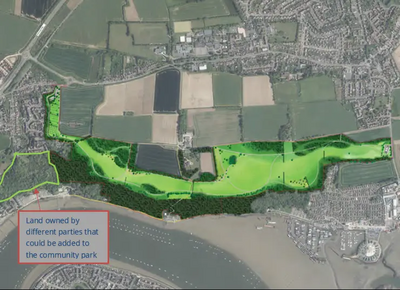
The proposed extension to the west of Cookham Community Park
Hoo Flats Community Park
This proposed community park is quite inspired and meets some of the aspirations written in the first-round brochure. MLD welcome the proposals as they achieve three goals in one park - the extension of community parkland east of Cookham Park provides more land for natural habitat. The extension prevents the enlargement of Hoo Marina Industrial Estate; a poorly laid out estate with not the best connections to Hoo and has noticeable poor air quality for such a small estate. The park extension also ensures that Hoo cannot "spread" to the riverfront.
Salt-marsh habitat and wet woodland transitioning are welcome additions to the parkland strategy.
The proposed Hoo Flats adjoin the east side of Cookham Community Park and ensures that the small industrial estate does not extend north and east
Lodge Hill and Deansgate Ridge Community Parks
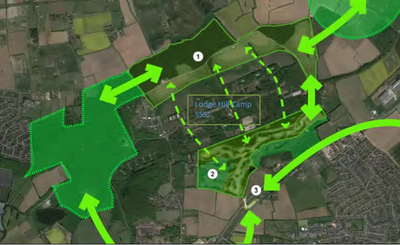
The most significant addition to the Second-Round consultation is the dual Lodge Hill and Deansgate Ridge community parks. The area they cover is not dissimilar to the Chattenden and Lodge Hill Country Community Park proposed by MLD. The point of concern is the omission Lodge Hill Camp. The former camp is a SSSI and thus it would make sense to incorporate and meld the land into the community parks and making the area one large community park. The other difference with the Second-Round consultation proposal and MLD's proposal is that Great Chattenden Wood is to be an adjacent SEMS, but not set to be a community park.
MLD seek clarification as to why the former Lodge Hill Camp SSSI and Great Chattenden Wood are not included within the proposed community park.
The northern community park would act as an eastern greenbelt to Cliffe Woods, preventing housing creeping further eastwards over the hill into Great Chattenden Wood.
We also would like to know of the allocated costs for the community parks to see if there is sufficient money to achieve the original large MLD country community park to the north of Hoo.
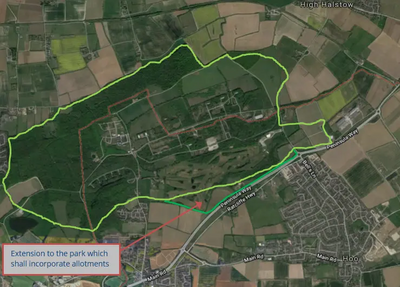
MLD are in favour of the proposed Green Bridge over Peninsula Way permitting access to Deangate Ridge Community Park. We would like to see cycle paths constructed either side of the bridge to permit cyclists to have save routes between Chattenden, Hoo, the community parks and Hundred of Hoo School.
We would support allocating some of this land to be reserved for allotments since there is a backlog across Medway and this land is good quality and would make excellent growing conditions for the current and additional residents of Hoo and Chattenden.

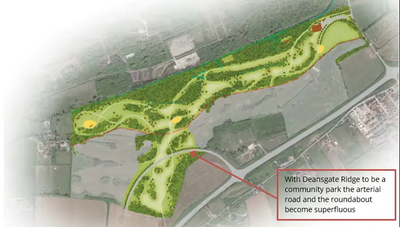
Rail Infrastructure
It was very disappointing to read the rail section in the Second-Round consultation. There has been no significant development of the rail design. There is no description informing the public to what GRIP stage the project has moved. It would be anticipated that the project would be at GRIP 4 by the Second-Round consultation. Instead, we are informed that there is a new GRIP 2 proposal for a shunting platform at Northfleet Station.
The design of Sharnal Street Station near Hoo has not been further developed since the last round of consultation, and the road that would connect it to Roper's Lane and Stoke Road has been omitted in the highways section.
The most significant statement is that the line is to have its own bi-modal rolling stock which shall travel back and forth between Hoo and Northfleet. The reason given for this is that the cost of third rail electrification is too expensive. But surely the cost of buying/leasing/altering existing stock to bi-modal rolling stock only for one stretch of line would also be extremely expensive? We would like to be provided with the indicative cost of laying third rail DC electrification.
Cooling Street Station

The single line requires a rail loop partway along the line between Hoo Junction and Hoo Station. In the first-round consultation we proposed that a station be built at the Cooling Street loop as trains will have to stop and wait. In the second-round document there is a statement that additional stations have been considered at Church Street and Cliffe, but "these have been discounted due to the proximity of Higham Station". Yet the distances from these stations and certainly the proposed Cooling Station that MLD are proposing are greater than that between Strood and Gillingham, yet there are two other stations between them. Therefore, we repeat that a station should be constructed at the Cooling Street loop.
The rail proposals have not been adequately thought through in both making the opportunity of the Cooling Loop and enabling future passenger services to Grain
Hoo Station
The lack of design development for the station is very disappointing. The design seems to degenerate at each consultation stage. The initial design by Pell Frischmann remains, in the opinion of MLD, the best design to date. Thus, it is a very sad outcome and output for Hoo Station from what was originally a good concept to the current dismal version of the proposed station.
It is our opinion that the station should be named Hoo Station and be built on the current rail alignment, which would be twin tracked at the station to form a return loop. This would ensure that passenger trains can extend to Grain in the long-term.
Shunting Platform at Northfleet Station

The proposed shunting platform at Northfleet Station is only required due to the proposal of bi-modal rolling stock that shall only travel between Northfleet and Hoo. And this rolling stock is only being considered because "DC electrification …. would have been prohibitively expensive". Please provide the indicative costs for (i) the third rail electrification and for (ii) the construction of the shunting platform plus the buying/leasing of bi-modal rolling stock and the cost of conversion of existing rolling stock to bi-modal operation.
Confirmation is requested regarding the funding of this as aspect of the project. Is this to come from the HIF Rail fund? If so, why is Medway Council spending money on a station in Gravesham when it is not prepared to continue with the connection of the peninsula with the Medway Towns via the construction of the Higham Curve?
The options for a dedicated platform at Northfleet Station
MLD Rail Proposal
When comparing the time left to undertake the full rail aspirations in the HIF document and acknowledging how slowly rail infrastructure is implemented and completed, there is a high likelihood that nothing will be in place by April 2025. Therefore, we suggest that a strategic plan be put in place to ensure that the Rail fund be spent on elements that ensure the long-term aim of passenger services for the whole of the Grain line be instigated.
The MLD proposal is that the Grain line would have stations at Cooling Street Loop, Hoo, Middle Stoke and Grain Industrial Zone, with other locations, especially Allhallows, to be considered. The Grain line would be connected to the Medway Towns by the construction of the Higham Curve. Passenger services between the peninsula and the towns would also allow workers of the expanding Thamesport and the National Grid sites at Grain to travel there by rail as well as people from the towns to visit the peninsula for leisure activities. This would be in addition to services for residents of peninsula to both the Medway Towns and westwards to Gravesend and London.
With the current allocated rail HIF funds, we would ensure the compulsory purchase of the land needed to achieve the long-term aims listed above, that is the land for the Higham Curve and the four provisional stations, with Hoo Station built on the existing track alignment and not a terminal spur (as shown in the HIF brochure). We would also obtain fully costed plans for the third rail electrification and then instigate the roll-out of the electrification until the end of the HIF period. Electrification of the Grain line would remove the need for the altering of existing rolling stock to bi-modal/buying or leasing new bi-modal rolling stock and the construction of the shunting platform at Northfleet. All these would become superfluous by electrifying the Grain line and the money saved would be put to better long-term use.
By undertaking these works in the HIF period, we would be laying the foundations that ensure that the long-term aim of full passenger services to the peninsula. This would ensure Medway would not have to return the HIF grant money for the rail portion. Something that is highly probable based upon the current HIF Rail content of the Second-Round brochure.
Cycle Paths
The Second-Round brochure again hardly mentions a form of transport that has become more popular in both means of commuting and for leisure, i.e. cycling. There is a paltry paragraph on page 53 about cycling, stating "provisions will be provided to improve connectivity", but there are no detailed descriptions of where these shall be built. We would use some of the highway funding and some of the greenspaces funding to design and construct a network of cyclepaths that can be used for both commuting and leisure.
Commuting Cyclepaths
Cycling to and from work and schools has become popular in recent years and we think that a portion of the highway budget should be spent on building new cyclepaths that are biased towards commuting.
Cyclepaths we have identified for commuting are:
- Hoo Station to Thamesport
- Hoo to Medway City Estate
- Hoo to High Halstow
- Hoo (including the Hundred of Hoo School) to Chattenden
Leisure Cyclepaths
There are three significant leisure cyclepaths that could be constructed on the peninsula these are:
- Cliffe Marshes - a cycle path that takes people from Cooling Station towards Cliffe and then onto the sea wall around the Cliffe Marshes and onto Egypt Bay and ending at Allhallows
- Allhallows to Grain Marshes and then to Grain
- Allhallows to Stoke and then along River Medway to Hoo
These use a combination of the new stations, existing roads and new cyclepaths to allow locals and visitors to cycle around the beautiful parts of the peninsula.
Submission from Medway Liberal Democrats on the Future Hoo -Consultation 2021 - Second Round
Highways
The highways section has some amendments, but still does not provide current and projected future traffic flows to and from the peninsula. The most congested junction along the Wainscott Bypass is the roundabout at the bottom of Four Elms Hill, but the proposal remains a traffic light controlled gyratory. There are still proposed projects that do not give value for money and we believe these should be removed, using the money saved to improve the design and construction of those junctions that would otherwise continue to severely affect traffic flow.
Medway Council has listed in its Infrastructure Delivery Plan (2021) that there is a critical requirement for "additional costs including contingency" for the Road Scheme, at a cost of £18.3m - this is outside of the specific £86m HIF Project highway budget and represents an overspend. The Council does not currently have a source of funding identified for this work.
Medway Council has not demonstrated that it has taken into account the potential effects of the proposed Lower Thames Crossing (LTC) on the A289, particularly with regards to the M2 J1. Highways England "cannot currently support the Local Plan due to the lack of modelling work".
Proposed Single Carriageway By-pass
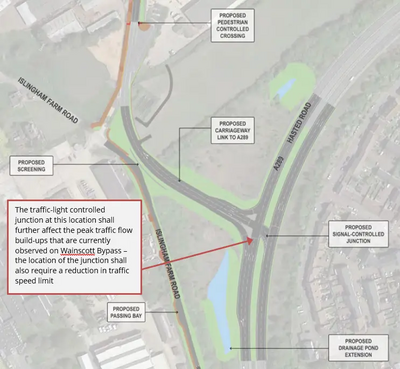

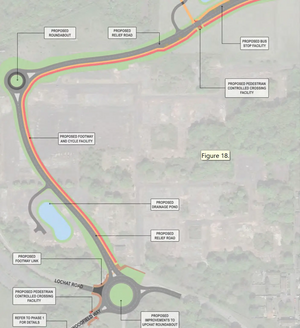
The single carriageway from Chattenden to Wainscott Bypass is still retained in the Second-Round brochure, but with the Wainscott Flyover removed and replaced with a traffic light controlled junction. The road that forms this Four Elms Hill "bypass" is Woodfield Way, which shall still be owned by the MOD, who shall retain the right to close it for training operations. Buses and HGVs shall not be permitted to use the road and it will have a 20mph speed limit for a stretch of road near the REME barracks. All these restrictions hardly ensure that traffic flow will be truly lessened on Four Elms Hill, yet it will act as a "rat run" for traffic into and through the enlarged residential area of Chattenden.
MLD remain against this proposed scheme, believing it does not provide value-for-money, as the additional by-pass is a single lane carriageway and its capacity shall be quickly overloaded. We request that Medway Council release the CoBA report that shows Woodfield Way "bypass" to be a viable project.
The proposed scheme has not been given an indicative cost. The length of the single carriageway secondary by-pass along with Woodlands Way remaining within MOD ownership makes the proposal ridiculous. It should be removed from the overall scheme forthwith.
The proposed scheme has not been given an indicative cost. The length of the single carriageway secondary by-pass along with Woodlands Way remaining within MOD ownership makes the proposal ridiculous. It should be removed from the overall scheme forthwith.
Arterial road is routed around and through former military camp has been slightly developed from the first-round - it is welcomed as a means of access to new housing being built on a brown field site - it is not welcome as part of the secondary by-pass
The A289 A228 Junction 1 - Four Elms Roundabout
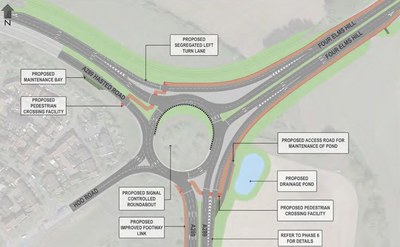
The most congested point on the Wainscott Bypass is at the roundabout with Four Elms Hill. We note that the proposals for the roundabout becoming a traffic light controlled gyratory with slip road connections on and off Four Elms Hill and improvements to pedestrian crossing facilities. But the most significant issue is the lack of through traffic flow from east bound traffic on Hasted Road continuing to Wulfere Way. This could be achieved by constructing a grade separated junction, to permit through traffic to continue without interruption. MLD would use the savings from the removal of the secondary bypass and the arterial road that would cut through Deangate Ridge to finance this junction improvement.
Four Elms Roundabout improvement is the most important junction design within the HIF project - this is already severely congested at peak hours and the increased population on the Hoo Peninsula will only make poor traffic flow worse. We propose that a significant portion of the highway fund be spent on upgrading and grade-separating this junction.
The only practical means of ensuring traffic flow, particularly generated traffic from an increased Hoo, is to make it grade separated. It is appreciated that there is insufficient space and scope for the roundabout and slip roads to be placed over the dual carriageway. Therefore, we recommend that the A289 dual carriageway be either placed in a cut-n-cover tunnel or on a viaduct over the roundabout.
It is also of note that there is currently an Air Quality Management Area at the top of Four Elms Hill because there are already current traffic issues. The air quality impact has not been modelled.
The grade separated option can be constructed in such a manner that there can be a traffic scheme in place to keep traffic flowing. Below is a means of constructing the junction:
- build a temporary clockwise road
- then construct the clockwise carriageway portion
- temporary transfer of anti-clockwise traffic onto the new clockwise carriageway
- construction of anti-clockwise carriageway
- transfer anti-clockwise to new permanent route
- complete clockwise carriageway
- transfer clockwise traffic to new carriageway
- complete gyratory traffic works
- remove remaining temporary road
The above example is provided as an example to how the junction could be constructed, because it is vital that traffic flow is maintained as well as the long-term aspiration of increasing the traffic capacity at the junction.
The A289 A228 Junction 2 - Sans Pareil Roundabout
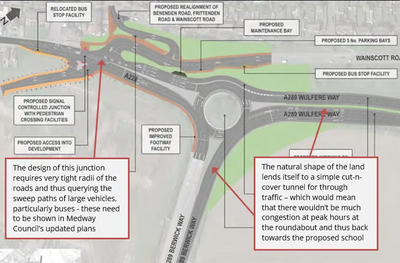
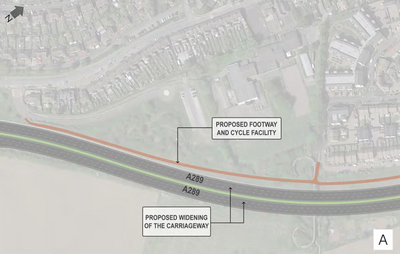
The second important junction redesign within the HIF project - is another already severely congested at peak hours roundabout at Sans Pareil - The natural formation of the land lends to the construction of a grade separated junction, this time with the dual carriageway would be set in a cut and cover tunnel.
The design of this junction requires very tight radii of the roads and thus querying the sweep paths of large vehicles, particularly buses - these need to be shown in Medway Council's updated plans
The natural shape of the land lends itself to a simple cut-n-cover tunnel for through traffic - which would mean that there wouldn't be much congestion at peak hours at the roundabout and thus back towards the proposed school
Here the natural geography could be used to benefit all, by the provision of another grade separated junction with the dual carriageway placed into a cut-n-cover tunnel, thereby separating the through traffic from local traffic, without dramatically affecting the current sight of vision lines across the remaining greenspaces. A grade separated junction would also ensure a safer space for pupils attending the proposed new secondary school, both from traffic flow and reduced vehicle emissions.
The widening of the dual carriageway south of Wainscott along with the proposed cycle path is accepted in reducing congestion.
Proposed Junction Improvements and Other Arterial Roads
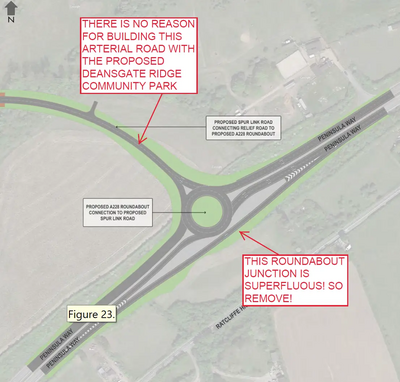

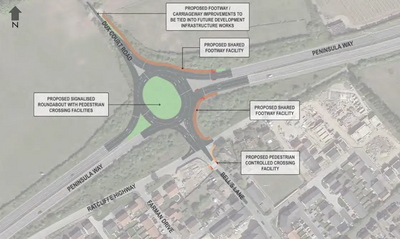
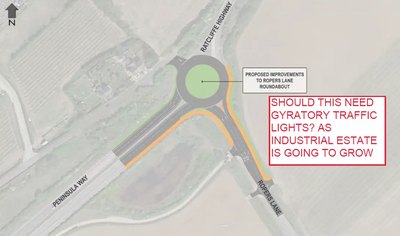
The document covers improvements to several junctions and the construction of arterial roads. It is our opinion that the proposed arterial road into Chattenden is constructed in an early phase of the infrastructure works, as there is a large brown field area that is suitable for accommodating a significant number of the housing units proposed for the Hoo area. However, we are opposed to the secondary by-pass down Woodfield Way, for the reasons given above.
The arterial road that cuts into the proposed Deansgate Ridge Community Park becomes superfluous by the very introduction of the park to the HIF plan. The proposed road never would have worked as the proposed secondary by-pass. Now that the area is to be parkland rather than residential then the arterial road should be removed from the HIF plan forthwith.
The proposed arterial road and its associated roundabout on Peninsula Way are superfluous with the introduction of Deansgate Ridge Community Park - the road never worked as a secondary bypass, but did as an arterial road - but is now superfluous with the community park - this road is opposed.
Option B is more superfluous than Option A and should be removed from the overall scheme.
There are junction improvement proposals at Bell's Lane, Dux Court Road onto Peninsula Way and at Roper's Lane onto Peninsula Way. It is our opinion that these should only be considered once the cost of financing the primary junctions and addressing the more dangerous junctions has been completed. The change of the junction from traffic lighted crossroads to traffic light controlled roundabout was anticipated by MLD in the first-round - the proposal is appropriate.
With the increase in traffic flow - especially with the growth of Kingsnorth Industrial Estate, the new Hoo Station and the eastern Hoo housing - there is concern that the roundabout should be constructed as a traffic light controlled gyratory.
It is of note that the Stoke Road roundabout and access road to the new Hoo station have not been further developed from the first-round consultation document. That there is no updated plan of this is of serious concern.
We would use some of the HIF Highway fund to address other junctions on the A228 that have safety concerns, particularly those at Middle and Lower Stoke. The highway fund should be used for improving the main road for the whole length of the peninsula and not just focused on Hoo and Chattenden.
Phasing of the Works
The second-round consultation brochure still does not determine the construction phases. This is a dereliction of duty. It should be obvious from traffic modelling which junctions need to be designed and then constructed first to make best/full use of the Highway fund in the remaining period of time for the works to be undertaken.
Costing of the Works
A notable omission from both the first and second -round consultation documents is the lack of estimated budget costs for each of the proposed schemes. We request that a Cost and Benefits Analyses report is released for review that shows the actual computed benefits for each of the proposed schemes.
Further action required
We recommend that the following be undertaken before the next round of consultations:
- CO2 and Air Quality impact studies
- Traffic modelling reports to provide greater evidence for the prioritisation of the various highway schemes
- Cost Benefit Analysis for the rail scheme, concentrating on future extension to Grain and the line connection to urban Medway
Conclusion
- The improvement on the detail for environmental part of the second-round brochure is to be applauded. We approve of the Hoo Flats Community Park. We have raised our concerns about not incorporating former Lodge Hill Camp SSSI into Lodge Hill Community Park and that Chattenden Woods is to be a separate SEMS.
- The dismal rail section in the second-round brochure is very disheartening - after almost a year from the aspirations of the Higham Curve and potential rail services - it is perturbing that the rail portion still has GRIP 2 level work and no indication of a future rail strategy for Hoo Peninsula
- We object to current rail design on multiple grounds
- if bi-modal is to include diesel then this contradicts Medway Council's declaration of a climate emergency when considering CO2
- the rail services shall not go to the destinations that the residents wanted i.e. London and Medway Towns.
- The updated highway proposals still have many flaws, ranging from order of phasing of the works, to building of new "rat runs" that shall fail on numerous criteria.
- The two currently over-loaded junctions, i.e. Four Elms Roundabout and Sans Pareil Roundabout remain inadequately addressed.
- There is very little in terms of new cyclepaths
- The brochure lacks any budgets, it does not specify the ring-fenced sums for the three specific aspects and it does not provide budget costs for each of the schemes within each aspect. Budget costs need to be provided so that we and the public can critique the options in further detail.
MLD Recommendations
Environmental Improvements
- The proposed community parks north of Hoo and Chattenden would be melded and enlarged to a country park by incorporating Lodge Hill Camp SSSI and Great Chattenden Woods.
- Funding would be made available from the Highways and Environmental funds to construct leisure oriented cyclepaths and footpaths on the northern shore of the peninsula.
Rail Proposals
- The rail design should be based upon the long-term strategy of delivering rail services to many more villages on the peninsula - this would be composed of three distinctive sub-projects-
- there would be a minimum of four stations - these being at:
- Cooling Street Loop for residents of Cooling, Cliffe and Cliffe Woods
- Hoo Station - notably it would be built on the current rail alignment with a loop (and not a spur)
- Middle and Lower Stoke and Allhallows
- near the line terminus for the industrial estate and Grain
- The Higham Curve would be re-introduced with the long-term aspiration of the connection between the peninsula and urban Medway
- DC electrification of the line should be made a priority - we would obtain a fully costed report and then instruct Network Rail to undertake the work.
- there would be a minimum of four stations - these being at:
- Rail HIF fund would be used to:
- compulsory purchase the land needed for the proposed stations and the Higham Curve
- DC electrification - initially to Hoo Station
Highway Proposals
- Money saved by the removal of the secondary bypass from the HIF plan to be used make improvements to junctions that are currently overloaded, let alone when more traffic is generated with the expansion of Hoo and Chattenden.
- Grade separated junctions to be designed and constructed at the Four Elms and The Sans Pareil roundabouts.
- Junction improvements to be made along the whole of the peninsula portion of the A228. Especially those that have data showing them to be dangerous, before money is spent on junction improvements to less dangerous junctions on the Peninsula Way bypass.
- There needs to be more effort given to providing commuting cyclepaths which specifically connect urban entities, e.g. residential areas to industrial estates and schools.
